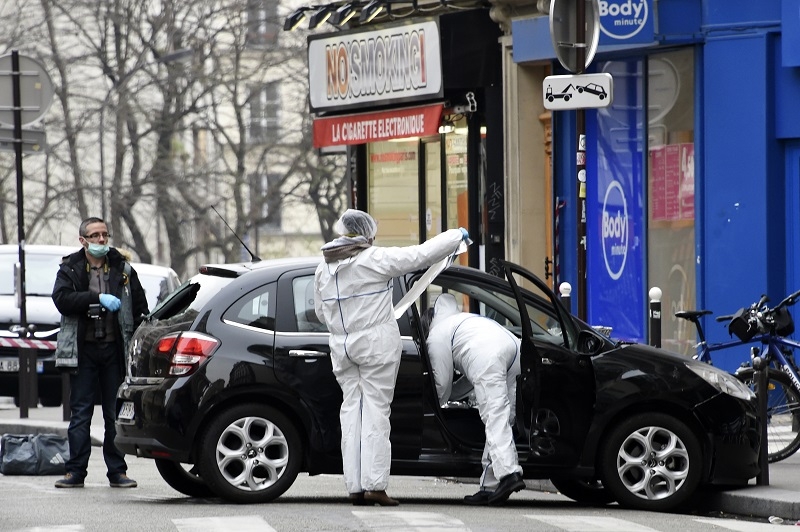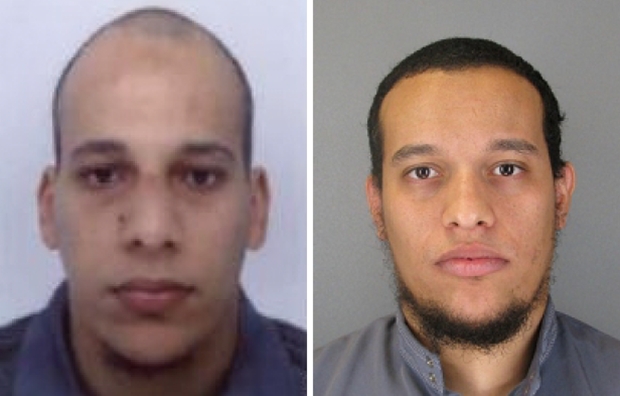Massive police manhunt underway following Paris massacre

REIMS, France - A raid by French anti-terrorist police was carried out Wednesday night as officers continued a massive manhunt for suspects in the Charlie Hebdo massacre in Paris earlier in the day.
The raid followed the Interior Ministry's denial of police reports that three men were under armed guard following their arrests.
Instead, the ministry confirmed the men had fled to Reims, some 160km from Paris, in eastern France, following the bloodbath which left 12 dead and four seriously wounded.
The suspects were named by police as Said Kouachi, 34; his brother Cherif Kouachi, 33; and Hamyd Mourad, 19.
All were believed to have been living in the Paris commuter town of Gennevilliers, and were caught after one left his identity card in their getaway car after today’s atrocity. The Kouachi brothers also had links with the Paris suburb of Pantin, where another anti-terrorist police raid took place today.
According to AFP news agency, a source close to the case said the youngest suspect handed himself over to police at 2300 local time on Wednesday. Paris police released the other men's photos, and launched an appeal to the public for more information. They said arrest warrants had been issued for the Kouachi brothers, who were "likely armed and dangerous".
Hamyd is believed to have been living recently in Charleville-Mezieres, in the Ardennes.
Officers from the RAID - Research, Assistance, Intervention, Deterrence – France’s elite special operations tactical unit, flooded a residential district of Reims. Police snipers were seen pointing their rifles at a number of flats, as heavily-armed colleagues stood by.
Search-and-seizure operations also took place in Strasbourg and other towns near Paris. The building in Reims targeted by police commandos was later scoured by white-clad forensic police.
The attack at the notorious satirical magazine was described by French President Francois Hollande as a "barbaric attack on press freedom".
Police were among those gunned down by two masked men brandishing Kalashnikovs and a rocket-propelled grenade, and who burst into the Charlie Hebdo headquarters Wednesday morning.
Claiming to be linked to al-Qaeda, they reportedly said they were taking revenge for the publication of cartoons and articles mocking the Prophet Muhammad.
Artists including the magazine’s editor were among those killed, after the gunmen asked for him by name before shouting "Allahu Akbar" [God is great] between rounds of automatic gunfire.
As they jumped into their getaway car, one reportedly shouted: "We have killed Charlie Hebdo!"
Despite a fierce fire-fight with police, the men were able to get away in a hijacked car, and, within an hour of the shooting, appeared to have disappeared without trace.
Four of France's most revered cartoonists - Stephane Charbonnier, 47, Georges Wolinski, 80, Bernard 'Tignous' Verlhac, 57, and Jean Cabut, 76, - were among those executed by the masked killers, along with 68-year-old writer Bernard Maris.
Charbonnier, known by his pen name Charb, was the editor of Charlie Hebdo, and is famous for saying "I'd prefer to die standing than live on my knees".
He also declared, in the face of fierce threats from extremists, "I live under French law, not Koranic law".
One of the police officers killed was Charbonnier’s protection officer – a policeman who was given the job of bodyguard after extremists firebombed the Charlie Hebdo offices in 2011.
That attack came in response to the magazine's decision to publish a series of cartoons which caused huge offence to Muslims around the world.
A young mother and cartoonist who survived today’s atrocity said she had let the suspected al-Qaeda killers into the magazine's offices, on the second floor of an office block in the 11th arrondissement of Paris.
Corrine Rey said she had returned from picking up her young daughter from a kindergarten when she was confronted by two heavily-armed men wearing balaclavas.
"I had gone to pick up my daughter at day care, arriving in front of the magazine building, where two masked and armed men brutally threatened us," said Rey, who draws under the name "Coco".
"They said they wanted to go up to the offices, so I tapped in the code," said Rey, referring to the security system intercom.
Rey and her daughter hid under a desk, from where they saw two other cartoonists being executed.
"They shot Wolinski and Cabu," she said. "It lasted five minutes. I had taken refuge under a desk".
Rey said the men "spoke French perfectly" and claimed they were members of "al-Qaeda".
The men shouted that they were from al-Qaeda in Yemen, said Cedric Le Béchec, a 33-year-old estate agent, who also witnessed the attack.
Le Bechec said that before launching the assault, they approached another man in the street saying, “Tell the media that this is Al Qaeda in Yemen”.
A Paris police source said the "organised commando" was made up of "two calm and determined gunmen who went directly up to the editorial room and knew their target in advance".
"It was Charb they were targeting," said the source. "The two attackers looked for him in the room, shouting, 'Where is Charb?' Where is Charb?'"
Pierre de Cossette, another eye-witness, said the men wore black balaclavas and were heard to shout "The Prophet has been avenged".
Benoit Bringer, a journalist who works next door, took refuge on the roof of the building, saying: "There were very many people in the building. We evacuated via the roof just next to the office. After around ten minutes we saw two heavily armed, masked men in the street".
When shots rang out, it is thought that three policemen on bicycles were the first to respond before being repelled by the attackers.
President Hollande visited the scene on Wednesday. "We will look for those responsible," he said, adding that the entire nation was "profoundly saddened" by what had happened.
Hollande said there was no doubt it was a terror attack "of exceptional barbarity" - adding that "several terrorist attacks were thwarted in recent weeks".
When the offices of the same magazine were burnt down in 2011, Charbonnier said Islam could not be excluded from freedom of the press. "If we can poke fun at everything in France, if we can talk about anything in France apart from Islam or the consequences of Islamism, that is annoying," he said.
Charbonnier said he did not see the attack on the magazine as the work of French Muslims, but of what he called "idiot extremists".
The 2011 attack came a day after the magazine's cover depicted the Prophet Muhammad saying "100 lashes if you don't die of laughter".
Inside there was an editorial, attributed to the Prophet Muhammad, and more cartoons, including one showing the Prophet with a clown's red nose.
Depictions of the Prophet are strictly prohibited in Islam - but the magazine denied it was trying to be provocative.
This week's edition of Charlie Hebdo features a story about French author Michel Houellebecq’s new novel. The book is about a Muslim running France according to the laws of conservative Islam.
Founded in 1969 as Hara-Kiri Hebdo, Charlie Hebdo was published under the slogan "dumb and nasty".
Its founding editors, humorist Georges Bernier and Francois Cavanna, first fell out with the establishment in November 1970 after joking about the death of President Charles de Gaulle.
New MEE newsletter: Jerusalem Dispatch
Sign up to get the latest insights and analysis on Israel-Palestine, alongside Turkey Unpacked and other MEE newsletters
Middle East Eye delivers independent and unrivalled coverage and analysis of the Middle East, North Africa and beyond. To learn more about republishing this content and the associated fees, please fill out this form. More about MEE can be found here.





